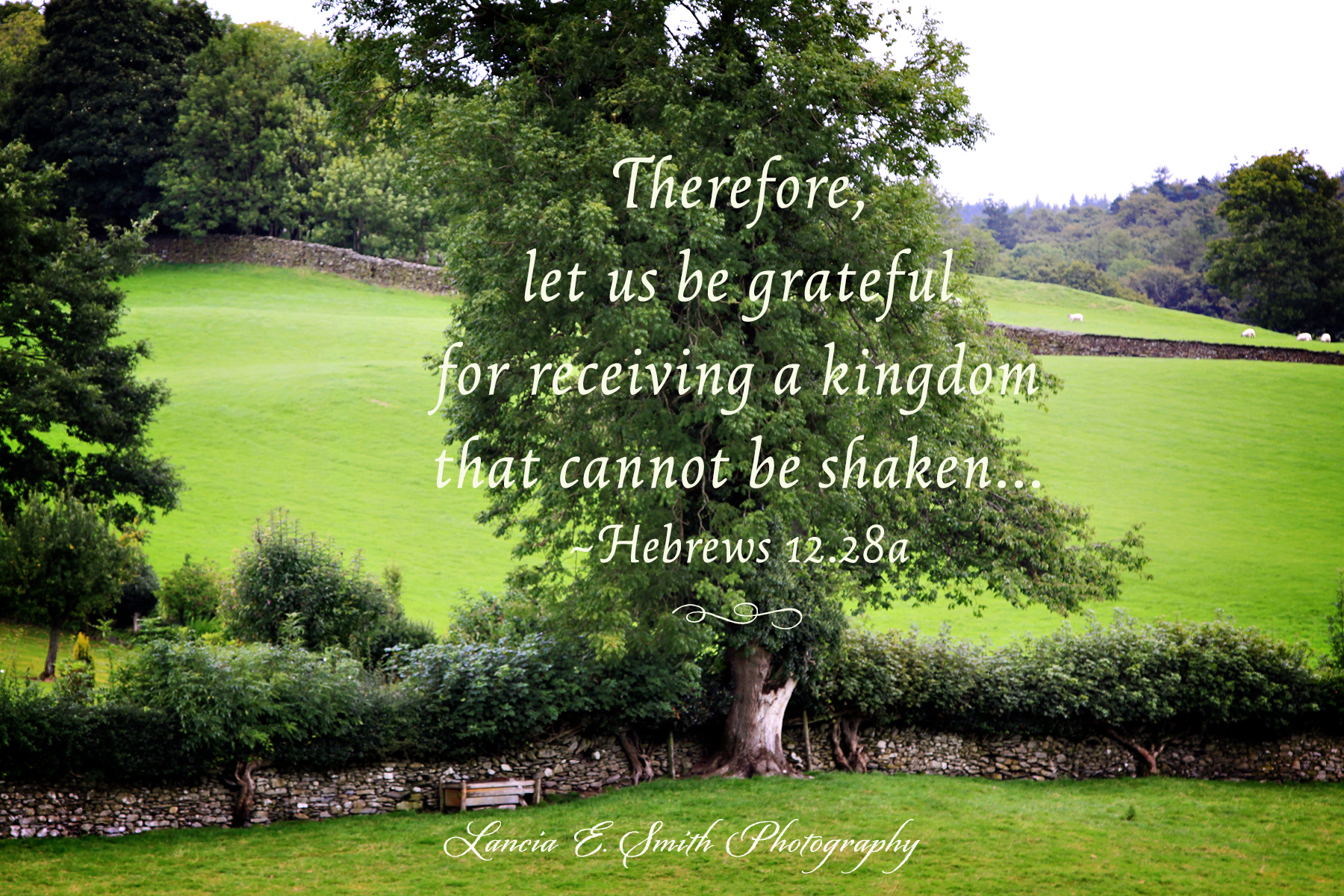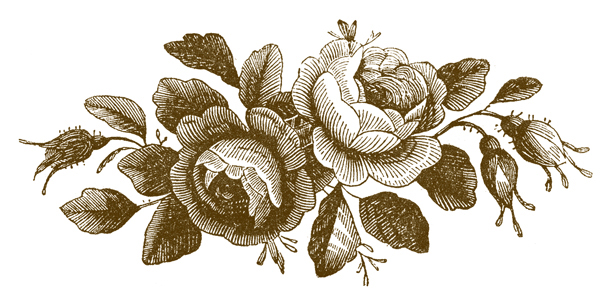In August I had the privilege of preaching at my church. My sermon text came from the end of Hebrews 12, the passage about the unshakeable kingdom:
At that time [God’s] voice shook the earth; but now he has promised, ‘Yet once more I will shake not only the earth but also the heaven.’ This phrase ‘Yet once more’ indicates the removal of what is shaken—that is, created things—so that what cannot be shaken may remain. Therefore, since we are receiving a kingdom that cannot be shaken, let us give thanks…
As I delved into the words of Hebrews this summer, I was caught up in the writer’s vision of the unshakeable kingdom—the kingdom of God that Jesus proclaimed was “at hand.” That means the unshakeable kingdom is here, now.
William Barclay says of this passage, “All things may pass away; the world as we know it may be uprooted; life as we experience it may come to an end; but one thing cannot change or end or be shaken—the relationship of the Christian to God. Even if everything else is shattered into eternal destruction that relationship stands eternally sure.”
The unshakeable kingdom springs from our relationship with Christ, the eternal Word and risen Lord; it is rooted in an unshakeable relationship with Jesus. An unshakeable relationship with Jesus!?! Yes, please! Sign me up! I want to live in the kingdom that cannot be shaken!
But we look around and we see shaking everywhere. We are shaken. We reel in shock and fear. As I studied and prayed over this passage from Hebrews this summer, I did so in the light—or rather the darkness—of recent events in our country and the world. And I asked God: What does it mean to live in the unshakeable kingdom right here, right now? What does that look like?
Strangely enough (or not so strangely; this is God we’re talking about after all), for the whole year prior to my sermon, I was learning what it meant to live in the unshakeable kingdom. God was showing me, concretely, what that looked like. I didn’t think of it in those terms, of course, but looking back I see now that God was preparing me, by experience, to preach on this passage, long before I ever knew I’d be preaching.
Over the past year I have embraced (or deepened) three practices that have radically transformed my way of being in the world, that have helped me to live more fully in the unshakeable kingdom. The transformation has been slow—three steps forward and two back (and some days I feel I’m only stepping backward!)—but slow growth accumulates and after a year, I am amazed at the work God has done in me. I put in my pitiful little seeds of effort and He multiplied them a hundredfold and more. I figure if these things worked for anxious, fearful, self-involved moi they’ll probably work for others, and I share them here in the hope that you’ll embrace them and find that they transform your life and vision, too, and help you to live in joyful and confident awareness of the very present kingdom of God—a kingdom that cannot be shaken.
I’ve framed these practices as questions, to make them easier to remember. The questions are: Where are you standing? Where are you looking? What are you saying?
Where are you standing?
On the day my twins were born—and one of them was in critical condition at death’s door—on that day, I read these words from Streams in the Desert:
“No matter what the source of the evil, if you are in God and surrounded by Him as by an atmosphere, all evil has to pass through Him before it comes to you.”
That image was deeply comforting to me in those dark, scary days, and I’ve never forgotten it.
My entire adult life—and for most of my teen years, too—I have struggled with chronic anxiety. Last summer I began to intentionally inhabit this image of God as atmosphere. I imagined—and I continue to imagine—Jesus surrounding me. I imagine myself standing in the circle of His love. I remind myself that whatever comes to me comes through Him.
When I feel anxious or afraid, I grab the anxiety, wherever it is in my body—usually it’s in my chest, sitting on my heart like a weight. I grab it and I place it in His outstretched hands. I ask Him to burn it up in the fire of His holy love. At first, I had to do this a lot—I’m talking every minute sometimes—but over the course of the last year, as I’ve faithfully given the anxiety to Jesus, my anxiety levels have plummeted through the floor. Which is not to say I’m never anxious—I still am, sometimes—but I’m no longer afraid of being anxious because I know what to do with anxiety when it comes. In that sense it’s lost its power over me.
As I live more and more consciously inside the circle of God’s love and protection, I find that I am stronger. I am more able to take things in stride. I don’t fall apart so easily. The tragic events of this summer have grieved me, but they have not devastated me the way they would have a couple years ago. They have not shaken my foundations. Where before they would have prompted me to fear and despair, they have instead prompted me to pray.
The question “Where are you standing?” is an invitation to imagine Jesus standing before us, surrounding us like an atmosphere—because He is! I’ve found it helpful to actually hold my arms straight out in front of me, with my palms turned outward. Then I move my arms out to my sides, as if I’m creating a barrier an arm’s length away from my face and body. This motion reminds me that Jesus is standing about me as a hedge of protection, and that everything that comes to me passes through Him first. He bears the brunt of it, carries most of the burden, leaves us only our share of the load. Though it feels heavy—though it is heavy—He knows we can bear it. We may not know we can bear it, but He knows we can.
Where are you standing? Stand in Christ. Keep yourself steadily in the circle of His holy love.
Where are you looking?
We just pictured Jesus standing before us with His arms around us in protection and embrace, our unshakeable shield. Now we need to look at Him.
I have two things to say here. The first is that if we want to look at Jesus we must immerse ourselves in the Gospels, for that is where we see Him most clearly. Hannah Hurnard (whom you may know as the author of Hind’s Feet on High Places) writes in her book Winged Life:
“In the four Gospels we have a most beautifully true and lifelike portrait of our Lord and Savior and Redeemer, Jesus Christ; not, certainly, of his personal appearance, but of himself, his character, his reactions to every conceivable circumstance and person. We know exactly what he is like with sinners, with suffering and sorrowful people, with hypocrites and self-righteous Pharisees, and with the needy and distressed and lonely. …[All] we have to do is study this lovely portrait of Him continually, and when we pray picture this one who has revealed himself so intimately and fully as the lover of all [people]. I… find immense help in picturing, too, the kind of face such a one would have, the strongest, bravest, gentlest, kindest, most understanding and most challenging face that I can imagine.” (emphasis mine)
Frank Laubach, a missionary to the Philippines in the early- and mid-20th century and one of the most God-surrendered souls I’ve ever encountered, said in his fabulous book Prayer: The Mightiest Force in the World:
“How can we saturate our minds with Christ? There is but one way to get a true picture of Him. This is to read His life in the four Gospels so often that we know it by heart. We who wish to be Christlike ought never to allow a day to pass without reading at least a chapter of the Gospels.”
If you read just one chapter a day, you can read all four Gospels four times in a year. Just think how much more clearly we would see Jesus if we all did as Laubach instructs!
If we want to look at Christ, our first task is to turn our eyes upon Jesus, and we do this by reading the Gospels day in and day out.
Our second task is to keep our eyes on Jesus. Most of us most of the time are not looking at Jesus—we might look at Him now and again, but then we look away—and so we are shaken. Most of us most of the time are looking at ourselves. We live our lives in the posture of the woman in Luke 13:
Now Jesus was teaching in one of the synagogues on the sabbath. And just then there appeared a woman with a spirit that had crippled her for eighteen years. She was bent over and was quite unable to stand up straight. When Jesus saw her, he called her over and said, ‘Woman, you are set free from your ailment.’ When he laid his hands on her, immediately she stood up straight and began praising God.
Like this woman, we are bent over and curved inward. St. Augustine called it incurvatus in se—curving in on oneself. Simone Weil once wrote, “Sin is not a distance from God; it is a turning of our faces in the wrong direction.” Incurvatus in se is the wrong direction.
When I am curved in on myself, what can I see? Only my own navel. Incurvatus in se is the posture of self-protection, self-focus, self-pity, self-loathing, and ultimately despair. Every fault and flaw and failing looms large when all I can see is myself. Every injury and insult looms large when all I can see is myself. When I am curved in on myself, I become all that I can see, and because there’s not enough of me to handle let alone help everything that needs handling and helping, I eventually despair.
When I find myself spinning in my thoughts in a cycle of self-focus—whether that’s visions of grandiosity and grandeur or a death spiral of self-pity and self-loathing, I find it helpful to stand up straight, take a deep breath, and stretch out my arms. This posture is the opposite of incurvatus in se. It’s the posture of Jesus on the cross, His arms stretched wide to embrace the world. In this posture, I can look up—and see Jesus. I can look out—and see my neighbor. The one person I don’t see in this posture—is myself.
The woman who was bent over for 18 years, unable to straighten herself, lived in her body what many of us live in our spirits, and whatever else that story is about, it is also about Jesus healing us from being curved in on ourselves. He longs to straighten us up—to straighten us out—so that we can live with our arms wide in embrace and praise, and our eyes on Him.
Those of you who are paying attention have already noticed that my arm motion for remembering that Christ shields me and my arm motion for getting my head up and my gaze on Jesus are nearly identical. This is not an accident. God did that on purpose!
Thou, O Lord, art a shield about me. You’re my glory and the lifter of my head.
Our Lord shields and shelters us in His unshakeable kingdom so that we can stand up straight and look at Him and at one another without fear—for when we look at Him we see the love that casts out fear.
Where are you looking? Turn your eyes upon Jesus. And keep your eyes on Jesus.
What are you saying?
Do you remember the first thing the woman did when Jesus healed her and she was able to straighten her body for the first time in 18 years? “She stood up straight and began praising God.” She raised her arms in praise!
The writer to the Hebrews finishes chapter 12 of his letter by reminding his readers: “Therefore, since we are receiving a kingdom that cannot be shaken, let us give thanks, by which we offer to God an acceptable worship with reverence and awe.”
When we stand in Christ, we stand on the Rock, and no power of hell, no scheme of man can snatch us from His hands. When we look at Christ, we are looking at the author and perfecter of our faith. Jesus is the One who has already gone before us, and He is the One who walks beside us. He is our shield and shelter, our guide and companion.
Giving thanks is the natural outflow of a life lived standing in Him and looking at Him.
For years I kept a gratitude journal in which I jotted down places or ways I glimpsed the goodness of God during the day. I call them grace notes: Moments of beauty or stillness or joy. Moments when things could have gone terribly wrong, and didn’t. Moments I want to remember because they brought a smile to my lips or glad tears to my eyes. I’m not as diligent about writing down the grace notes these days—largely because giving thanks has become woven into the fabric of my life—but sometimes I get off-kilter and I realize I’m complaining or whining, and I start the gratitude journal back up. Good habits take a long time to take over!
Another way I try to keep words of thanksgiving on my lips is by singing praise songs or hymns as I go about my day. Sometimes I can sing aloud. Other times the song must be under my breath or in my mind. No matter. The important thing is that my mind is focused on words of praise. I grew up on those Maranatha praise songs from the 70’s, so those come to my mind readily (and if you don’t know them, they’re easy to memorize—and they’re usually straight out of Scripture). I also spent many years attending a Taize service at the local cathedral, so I have in my memory a good-sized store of Taize chants (which are also Scripture-based and easy to memorize). Since my children were babies, I’ve sung them hymns at bedtime—which has meant that I’ve had to keep expanding my repertoire of the hymns I know by heart. They’re easy to memorize because of their meter and rhyme, and they contain a lot of wisdom that we’ve lost in our contemporary milieu. Having this mental stash of songs to sing that are rich in Scripture and theology helps me not only to say thanks more often but also to keep my eyes on Christ.
What are you saying? Say thank you. Say praise.
Go and Do
Where are you standing? Where are you looking? What are you saying?
I hope the answer to all three of those questions is Christ:
Stand in Christ. Look at Christ. Give thanks to Christ.
These three simple (though not easy!) practices will, over time, help us to realize that we really do live—already—in the unshakeable kingdom of Jesus Christ.
I am always honoured and grateful to have K.C. Ireton
grace The Cultivating Project with her presence and good words!
The image of the magnificent oak tree growing in the stone wall
is one I made this summer while Peter and I were traveling in
England’s beloved Lake District.
K. C. Ireton is a multi-published author of both fiction and nonfiction books, including The Circle of Seasons: Meeting God in the Church Year and A Yellow Wood and Other Stories. She and her daughter, Jane, co-host Lantern Hill, a podcast for people who love books, children, and God. Visit kcireton.com to learn more about her work and download the first two chapters of her most recent book. Or visit her on Substack at kcireton.substack.com, where she publishes stories and liturgies.
Leave a Reply
A Field Guide to Cultivating ~ Essentials to Cultivating a Whole Life, Rooted in Christ, and Flourishing in Fellowship
Enjoy our gift to you as our Welcome to Cultivating! Discover the purpose of The Cultivating Project, and how you might find a "What, you too?" experience here with this fellowship of makers!



[…] you can listen to the sermon. Or if 25 minutes of sermonizing seems a little long to you, you can head over to The Cultivating Project, where Lancia Smith has kindly published a revised and (somewhat) expanded version of the […]
This is such a blessing to me today, a wonderfully powerful message. Thank you so much for sharing this with us.
Dear Honor, I’m so glad it blessed you. Thank you for taking a moment to let me know! I pray that you would experience the unshakeable kingdom more and more fully.
Thank you Kimberlee, may the Lord continue to bless you as you shine for Him!
Thank you for writing. This is encouraging and convicting all at the same time.